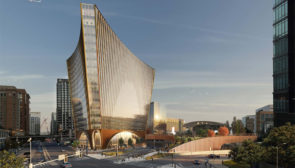Artistry in Design – The Luxury Report
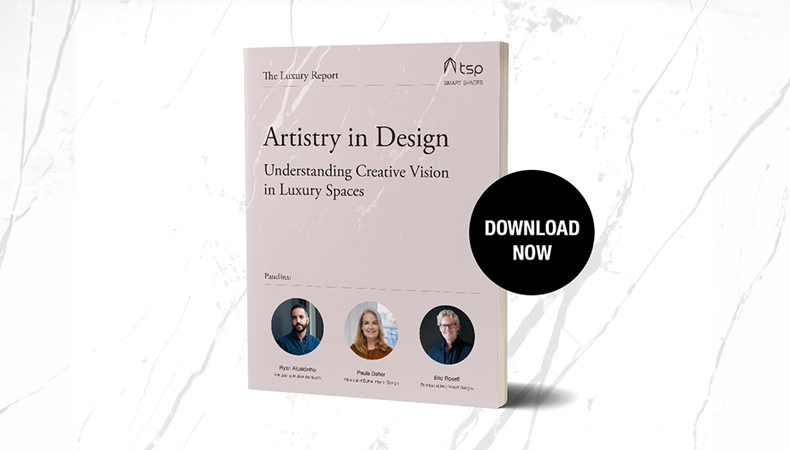
Download the Artistry in Design report
Understanding Creative Vision in Luxury Spaces
With today’s luxury real estate market, the integration of custom artistic elements has become increasingly central to high-end residential projects. This growing emphasis on artistry represents a fundamental shift in how luxury spaces are conceived and executed, particularly in markets like Boston where discerning clients seek to create unique, personalized environments that tell their stories through design.
Artistry in Design – Event Recap
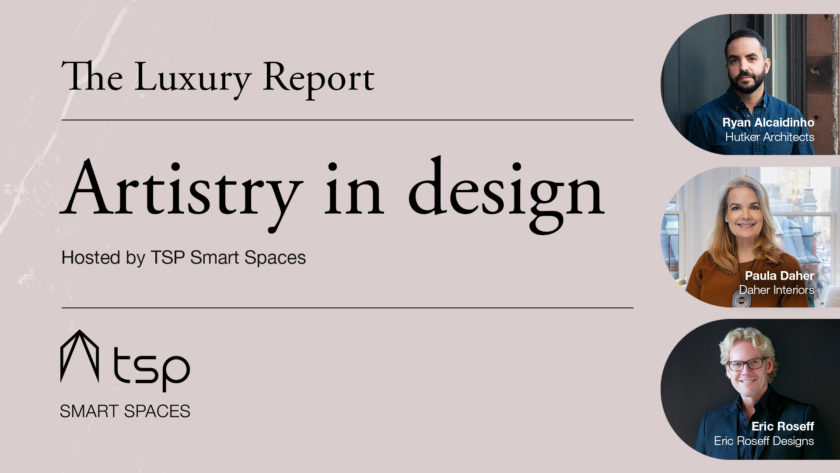
On October 30th, TSP Smart Spaces welcomed guests from the Boston architecture and design community to our Experience Lab for a panel discussion on artistry in luxury design. The evening featured three distinguished speakers who each presented remarkable projects that showcased different approaches to incorporating artistry into residential spaces:
- Ryan Alcaidinho, Principal at Hutker Architects
- Paula Daher, Principal at Daher Interior Design
- Eric Roseff, Principal at Eric Roseff Designs
Each speaker shared a unique project that demonstrated their approach to integrating artistic elements into residential spaces, from custom metalwork to plaster relief to intricate glass mosaics. The presentations highlighted the importance of collaboration between designers, artisans, and clients in creating truly exceptional spaces.
Key Themes and Insights
The Power of Narrative in Design
Modern luxury design has moved beyond mere aesthetics to embrace storytelling as a fundamental element. This shift reflects a deeper understanding that exceptional spaces must resonate with their occupants on an emotional level. Successful designers now begin their process by understanding not just how a space will be used, but what story it needs to tell.
This narrative approach was demonstrated in Paula Daher’s One Dalton project, where she transformed a client’s favorite 12th-century poem into a stunning plaster relief installation. The piece not only served as an artistic focal point but created a deeply personal connection between the resident and their space. Similarly, at Hutker Architects, Ryan Alcaidinho describes how they begin each project by asking clients to “tell us your perfect day,” using these personal stories to inform everything from room layouts to material selections.
The narrative approach transforms standard architectural elements into meaningful features that connect residents to their environment. Alcaidinho discussed a waterfront project that perfectly exemplifies this, where beach elements like snow fencing and weathered stones inspired interior architectural features. The striking stair installation, with its custom metal links connecting wooden slats, directly referenced fencing found on the property’s beach, creating a sophisticated dialogue between indoor and outdoor spaces.
Client Trust and Creative Freedom

The relationship between designer and client has evolved significantly in luxury projects. Traditional client-designer dynamics often focused on executing a predetermined vision. Today’s most successful artistic installations emerge from deep, trust-based relationships where clients become partners in the creative process rather than just decision-makers.
Eric Roseff’s work provides a compelling example of how these relationships develop over time. He discussed a 12-year relationship with a client that evolved through five different homes, each project becoming more ambitious than the last. This progression culminated in a spectacular entrance installation featuring 18-foot snakes and butterflies rendered in hand-cut Murano glass mosaic – a design that required extraordinary trust and creative freedom to execute.
This evolution in client relationships typically develops over time. Initial projects might be relatively conservative, but as trust builds, clients become more receptive to bold artistic concepts. Paula Daher illustrated this when describing how her client gave complete creative freedom for the plaster relief installation, choosing not to see it until completion. “I don’t want to see it. I just want to see it when it’s finished,” the client said, demonstrating the level of trust necessary for truly innovative design.
Artistic Collaboration and Craftsmanship
The integration of artistic elements in luxury spaces demands a new model of collaboration between designers and craftspeople. Success requires moving beyond the traditional sequence where craftspeople simply execute a designer’s vision. Instead, early collaboration has become essential, with fabricators and artisans contributing their expertise during the conceptual phase.
This was evident in Roseff’s entrance installation, where the complexity of transitioning glass mosaic from walls to floors required close collaboration between him and Installations Plus’s technical experts. The project’s success hinged on solving numerous technical challenges, from matching mosaic thicknesses to achieving precise grout lines of just 1/16th of an inch.
Similarly, Alcaidinho’s stair installation required coordinating multiple fabricators including Herrick and White from Rhode Island for beams and Modern Metal Solutions from New Hampshire for stair components. Each brought specific expertise that influenced the final design. As Alcaidinho noted, “Knowing how something is made makes it better” – a philosophy that emphasizes the importance of understanding fabrication techniques during the design phase.
Innovation in Materials and Techniques

The luxury market’s appetite for unique artistic expressions has driven significant innovation in how traditional materials are used and combined. Contemporary projects increasingly blur the lines between functional architecture and art through creative material applications.
Metalwork, for instance, has evolved from purely structural or decorative applications to become a medium for creating transitions between materials and spaces. Modern techniques allow metals to be finished and detailed in ways that create dialogue with adjacent materials like wood or stone. These interactions can be highlighted rather than concealed, celebrating the craftsmanship involved.
Plaster, historically used for simple wall finishes or ornamental moldings, has been reimagined as a medium for contemporary artistic expression. New techniques allow for the creation of sophisticated relief work that can translate complex narratives into architectural features. These installations demonstrate how traditional materials can be used to create thoroughly modern artistic statements.
The Boston Design Aesthetic
Boston’s approach to luxury design reflects its unique cultural and historical context. Unlike markets such as Miami or Los Angeles, where ostentation is often celebrated, Boston’s luxury market gravitates toward what designers term “quiet luxury.” This philosophy emphasizes craftsmanship and material quality over obvious displays of wealth.
The region’s strong historical influences play a significant role in shaping contemporary design decisions. Modern artistic installations often reference historical architectural elements while reinterpreting them through a contemporary lens. This balance between tradition and innovation is particularly evident in how materials are selected and detailed.
Sustainability has become increasingly central to Boston’s luxury market, influencing both material selection and installation techniques. Clients frequently prioritize locally-sourced materials and artisans, viewing environmental responsibility as an essential component of luxury. This focus has encouraged innovation in how traditional materials are sourced and applied.
Strategies for Success
Early Team Integration
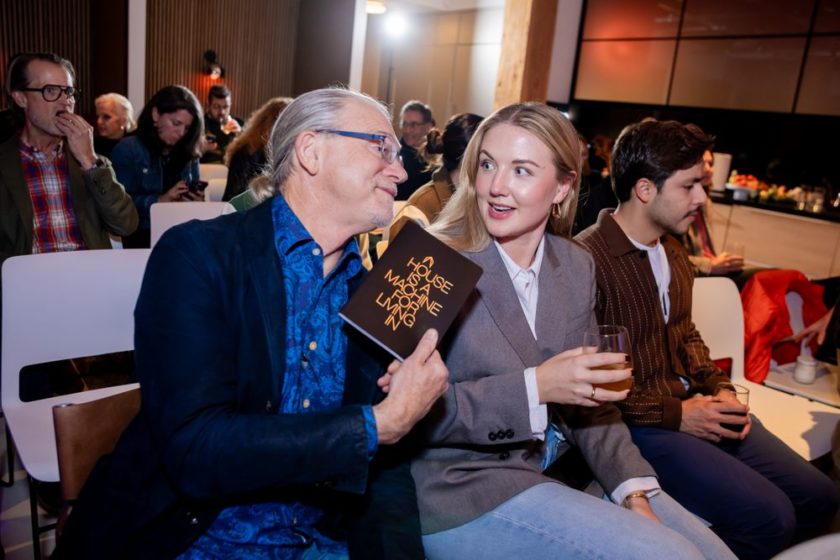
The complexity of artistic architectural installations demands a new approach to team building and project management. Successful projects increasingly bring fabricators, artisans, and installers into the design process during the conceptual phase rather than after decisions have been finalized.
Ryan Alcaidinho’s stair installation demonstrates why this early collaboration is crucial. The project required coordinating multiple specialists: millworkers for the wooden slats, metalworkers for the custom links, and installers who needed to achieve precise tolerances. “Getting that team together early on was critical,” Alcaidinho emphasized. “No one was like, ‘Oh, we can’t, let’s not go with this person because they’re X amount.’ We knew this was the part of the house that we really had to dial in and bring in the biggest players to kind of get this done.”
Early team integration also allows for productive problem-solving before construction begins. In Eric Roseff’s mosaic installation, the challenge of transitioning from walls to floors required extensive pre-planning between his team and Installations Plus. The team had to resolve complex technical issues around material thicknesses, grout lines, and curved surfaces before any installation began.
Building Trust-Based Client Relationships
Successful artistic installations require more than just technical expertise – they demand strong client relationships built on trust and understanding. Designers should focus on:
- Developing Clear Communication Channels: Regular updates and transparent discussions about challenges and solutions help build client confidence.
- Understanding Client Stories: As Paula Daher demonstrated with her One Dalton project, taking time to understand clients’ personal narratives and emotional connections can lead to more meaningful design solutions.
- Progressive Risk-Taking: Start with smaller artistic elements and gradually propose more ambitious installations as trust develops.
Material Innovation and Exploration
Today’s luxury projects often push the boundaries of traditional materials, requiring designers to:
- Challenge Convention: Eric Roseff’s use of clear grout in his mosaic installation, for example, created unexpected light-reflecting properties that enhanced the overall design.
- Combine Materials Thoughtfully: As seen in Hutker’s project, the interplay between metal and wood created opportunities for both structural and decorative innovation.
- Consider Maintenance: Innovative material applications must balance artistic impact with practical considerations of durability and maintenance.
Precision in Process
The success of artistic installations often comes down to meticulous attention to detail during both design and execution phases:
- Mockups and Prototypes: Alcaidinho’s team spent considerable time perfecting the proportions of their wooden slats, adjusting measurements by tiny increments until achieving the perfect scale.
- Documentation: Detailed shop drawings and clear communication between all team members ensure complex artistic elements can be executed as envisioned.
- On-Site Adaptation: Being prepared to make real-time adjustments during installation, as demonstrated in Roseff’s mosaic project where installers had to carefully manage material transitions.
Integration with Architecture
Artistic elements should feel integral to the architecture rather than applied as an afterthought:
- Consider Sight Lines: Each presenter emphasized the importance of how artistic elements are first encountered and experienced throughout the space.
- Balance Statement and Subtlety: Paula Daher’s plaster relief made a strong first impression while integrating seamlessly with the overall design.
- Create Meaningful Transitions: As seen in Alcaidinho’s project, artistic elements can help guide movement through spaces while telling a cohesive story.
Project Management for Artistic Installations
Complex artistic installations require specialized project management approaches:
- Flexible Timelines: Allow adequate time for artistic processes while maintaining overall project schedules.
- Budget Management: Understand that artistic elements often require investment in both materials and specialized labor.
- Quality Control: Establish clear standards and review processes, particularly for custom elements.
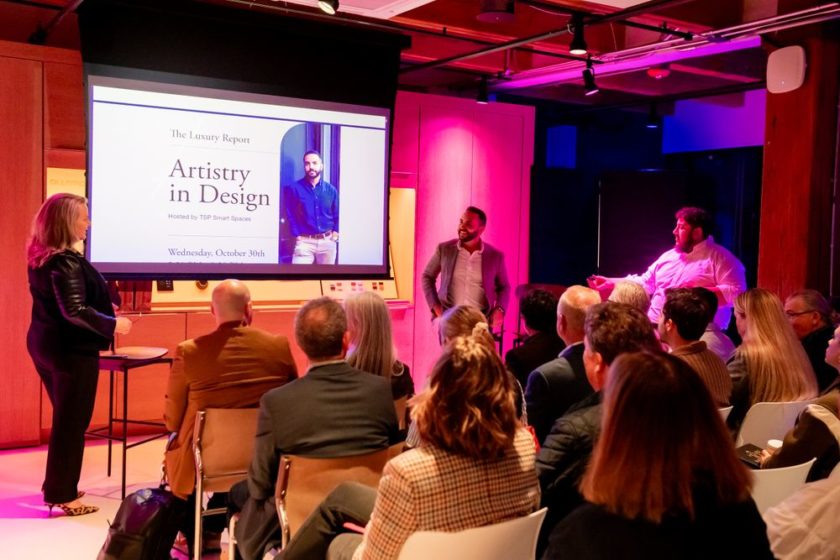
About the Speakers
Ryan Alcaidinho – Ryan is a Principal at Hutker Architects, where he has practiced since 2010. He brings expertise in high-end residential design with industry experience in both landscape design and luxury retail. Known for his keen eye for detail and innate ability to analyze visual information quickly, he creates thoughtfully designed spaces that reflect his comprehensive approach to architecture.
Paula Daher – Paula is the principal creative director of her award-winning design firm, where she combines classical training with an analytical mindset to create beautiful, functional interiors. Drawing inspiration from her frequent international travel, she brings a sophisticated perspective and strategic foundation to each project, ensuring spaces that are both innovative and timeless.
Eric Roseff – Eric is recognized for his talent in reimagining the ordinary into the extraordinary. As a versatile designer, his portfolio spans from East to West coast, town to country, and mountains to seaside. He brings an innovative flair to every project, skillfully blending colors, textures, and unique pieces to create spaces that bridge the design line continuum with distinctive style.
About TSP Smart Spaces
Our work in home automation and technology architecture began when a longstanding client, frustrated by the smart home technologists and integrators creating sub-par solutions for his own home, issued us a simple challenge: “Do better.” So we did. Leveraging our 27 years of strategic technology development and implementation, a diverse team of specialists based in Boston MA, and a long-standing commitment to innovative, bespoke, design-informed solutions, TSP looks beyond standard approaches to home automation by focusing on simplicity, seamless interaction, remote monitoring, reliability, and most importantly, a flawless user experience.



